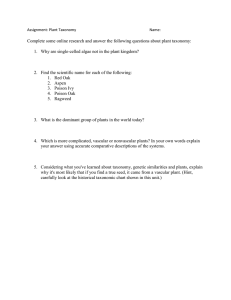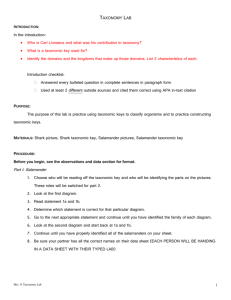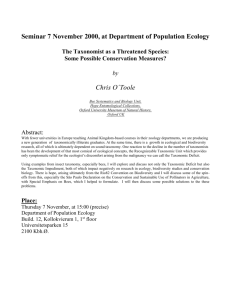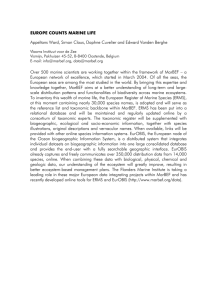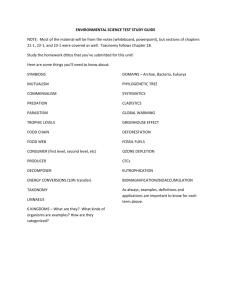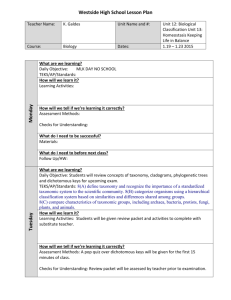Some statistics about NeMys...
advertisement
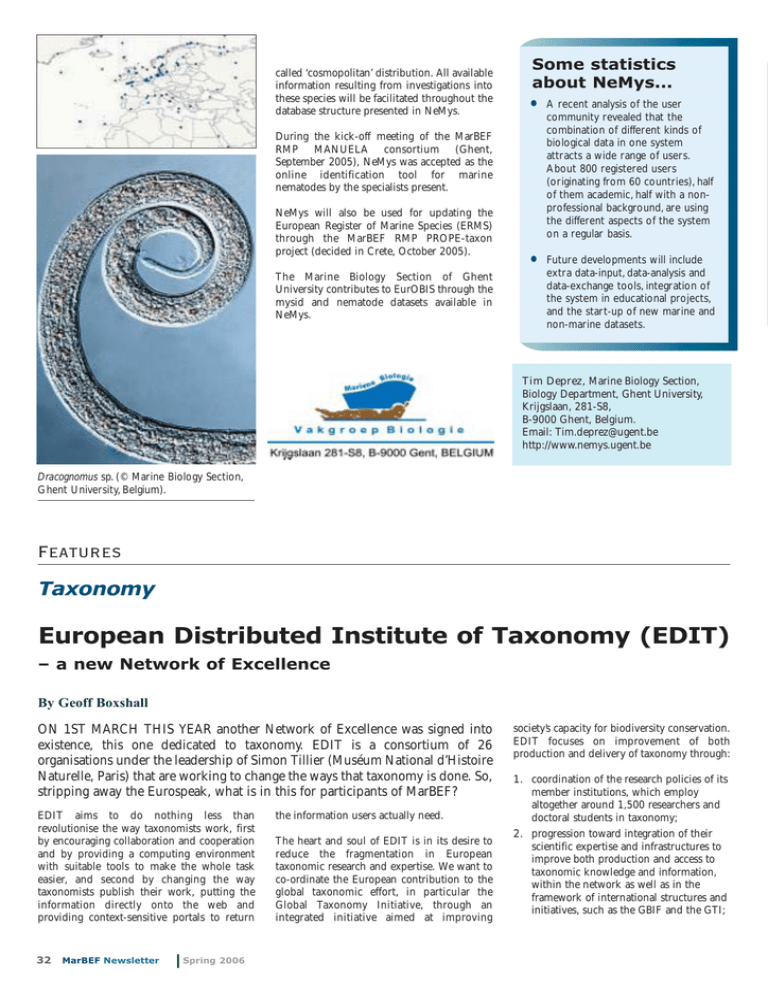
called ‘cosmopolitan’ distribution. All available information resulting from investigations into these species will be facilitated throughout the database structure presented in NeMys. Some statistics about NeMys... • A recent analysis of the user community revealed that the combination of different kinds of biological data in one system attracts a wide range of users. About 800 registered users (originating from 60 countries), half of them academic, half with a nonprofessional background, are using the different aspects of the system on a regular basis. • Future developments will include extra data-input, data-analysis and data-exchange tools, integration of the system in educational projects, and the start-up of new marine and non-marine datasets. During the kick-off meeting of the MarBEF RMP MANUELA consortium (Ghent, September 2005), NeMys was accepted as the online identification tool for marine nematodes by the specialists present. NeMys will also be used for updating the European Register of Marine Species (ERMS) through the MarBEF RMP PROPE-taxon project (decided in Crete, October 2005). The Marine Biology Section of Ghent University contributes to EurOBIS through the mysid and nematode datasets available in NeMys. Tim Deprez, Marine Biology Section, Biology Department, Ghent University, Krijgslaan, 281-S8, B-9000 Ghent, Belgium. Email: Tim.deprez@ugent.be http://www.nemys.ugent.be Dracognomus sp. (© Marine Biology Section, Ghent University, Belgium). Features Taxonomy European Distributed Institute of Taxonomy (EDIT) – a new Network of Excellence By Geoff Boxshall ON 1ST MARCH THIS YEAR another Network of Excellence was signed into existence, this one dedicated to taxonomy. EDIT is a consortium of 26 organisations under the leadership of Simon Tillier (Muséum National d’Histoire Naturelle, Paris) that are working to change the ways that taxonomy is done. So, stripping away the Eurospeak, what is in this for participants of MarBEF? EDIT aims to do nothing less than revolutionise the way taxonomists work, first by encouraging collaboration and cooperation and by providing a computing environment with suitable tools to make the whole task easier, and second by changing the way taxonomists publish their work, putting the information directly onto the web and providing context-sensitive portals to return 32 MarBEF Newsletter Spring 2006 the information users actually need. The heart and soul of EDIT is in its desire to reduce the fragmentation in European taxonomic research and expertise. We want to co-ordinate the European contribution to the global taxonomic effort, in particular the Global Taxonomy Initiative, through an integrated initiative aimed at improving society’s capacity for biodiversity conservation. EDIT focuses on improvement of both production and delivery of taxonomy through: 1. coordination of the research policies of its member institutions, which employ altogether around 1,500 researchers and doctoral students in taxonomy; 2. progression toward integration of their scientific expertise and infrastructures to improve both production and access to taxonomic knowledge and information, within the network as well as in the framework of international structures and initiatives, such as the GBIF and the GTI; 3. inducing cultural change, allowing improvement in the production of taxonomic results by building an internet platform for elaboration and publication of collaborative revisions on the web, and making this platform freely available to all taxonomists worldwide. Lofty goals indeed, and, as we all know, the devil is in the detail, so what is really going to happen? EDIT is divided into work packages (WP) (see figure), and the heart of the project lies in three components: the cyber-platform (WP5), revisionary taxonomy (WP6) and biodiversity inventories and monitoring (WP7). WP5, led by Walter Berendsohn (Freie Universitaet Berlin – Botanical Garden and Botanical Museum), will create a cyberplatform that will provide productivity tools for those engaged in taxonomic research, including making certain resources available over the net. Walter and his partners in Kew, Budapest and Stuttgart will begin there with a formal analysis of the way taxonomy is actually done to determine where there are bottlenecks and what tools would help to alleviate them. WP6, let by Dave Roberts (Natural History Museum, London), will devise a webpublication structure for revisionary taxonomy, from single species through to phylum-level revisions (or higher for the microbiologists). We will start by working with four exemplar groups from the Araceae (palms), Compositae (daisies), Lepidoptera (butterflies and moths) and the Cryptomonads as model revisions to define the necessary data structure. We plan to produce machine-readable text as well as traditional-looking “paper” documents. The machine-readable component will allow the integration of more than one revision as well as individual species descriptions, allowing the portal itself to synthesise the best available answer to questions and, hopefully, to build identification keys, checklists and other taxonomic products on the fly. With a draft definition of a data format, we will be in a position to open the range of taxa that are included within the system. WP7, led by Christoph Häuser (Staatliches Museum für Naturkunde, Stuttgart), will focus on field work and the application of taxonomy to conservation. Christoph has issued a call for suggestions for sites to act as foci for all-taxon biotic inventories. Perhaps one of these sites should be marine and therefore of considerable interest to MarBEF members. The requirements of these studies will feed back into the tools being developed in WP5 and the information being delivered in WP6. WP8, led by Jackie van Goethem (Royal Belgian Institute of Natural Sciences), will assess the availability of training resources and will develop a pilot scheme for integrating training schemes, particularly by identifying gaps in the current provision. It aims to develop capacities beyond the consortium, in accordance with GTI objectives. WP2, led by Henrik Enghoff (Natural History Museum of Denmark, University of Copenhagen), will produce an online service providing information on available taxonomic expertise within Europe, and a similar service providing information on ongoing taxonomic research that will help to establish collaborative networks, and will identify groups for which expertise is lacking; hopefully it will be used by European institutions as a guide to recruitment. WP3, led by Wouter Los (University of Amsterdam), will address issues relating to the infrastructural base of European systematics with a view to improving integration. A central component of this effort will be the development of standards to facilitate data sharing, particularly in the burgeoning area of DNA barcoding, and the development of a Bioinformatics Toolbox to make use of these data. WP4, led by Marian Ramos (Museo Nacional de Ciencias Naturales, Madrid), will address the question of coordinating taxonomic research within Europe, specifically by promoting synergy between research teams around the needs of end-users of taxonomy and by exploring prospective areas for future collaborative efforts. As members of MarBEF are well aware, a Network of Excellence funds little actual research, but can provide travel funds for workshops and to facilitate collaboration. EDIT does support some research posts that are devoted to infrastructure development, specifically relating to the cyber-platform and web publication. How does all this relate to MarBEF? The whole question of biodiversity, no matter how you define it, is intimately linked to taxonomy. At a practical level, EDIT will make the production of taxonomic revisions and identification keys easier, so hopefully more modern taxonomic treatments will become available, especially for the less intensively studied groups of organisms. EDIT will also facilitate the publication of new taxonomic descriptions that can be incorporated into existing revisions on demand. At a fundamental level, though, EDIT will change our approach to taxonomy and lead us away from the lone taxonomist beavering away on a particular group and into an integrated whole that can bid successfully for funding to address large-scale problems of both taxonomy and systematics. The MarBEF objectives of improving training, enabling biodiversity surveys and monitoring, and access to resources, have clear interactions with EDIT programmes 8, 7 and 6. The common challenge for both networks is in working together to construct a research infrastructure that includes taxonomy and ecology. EDIT is just starting up and will be recruiting its supported researchers in March with a programme-start meeting in June. There is much goodwill between the two networks and hopefully we can achieve synergy between networks as well as institutions and, best of all, between people. Geoff Boxshall Natural History Museum Department of Zoology London Email: gab@nhm.ac.uk Spring 2006 MarBEF Newsletter 33
